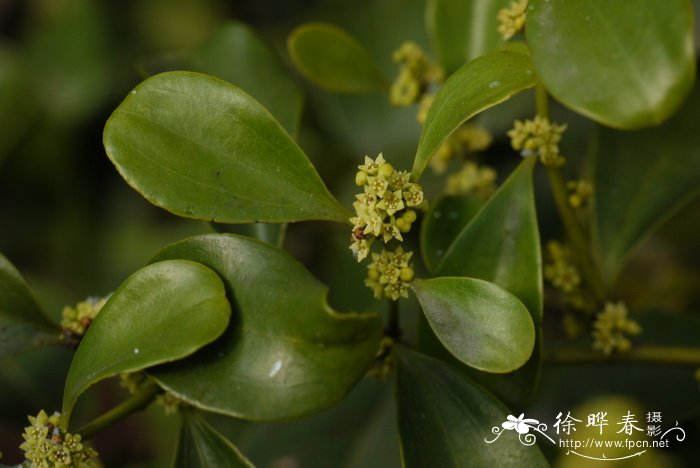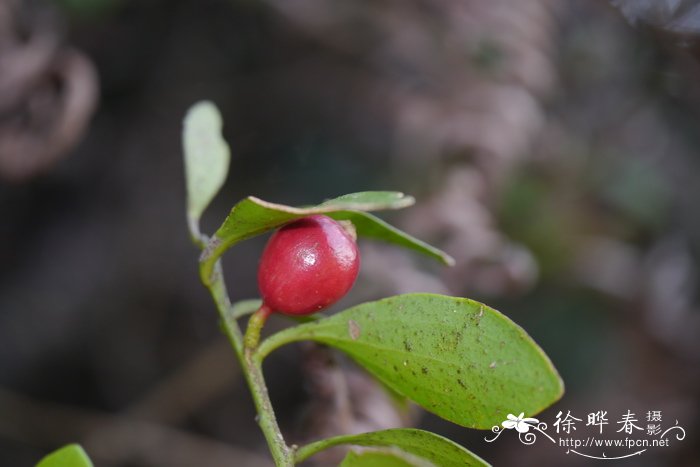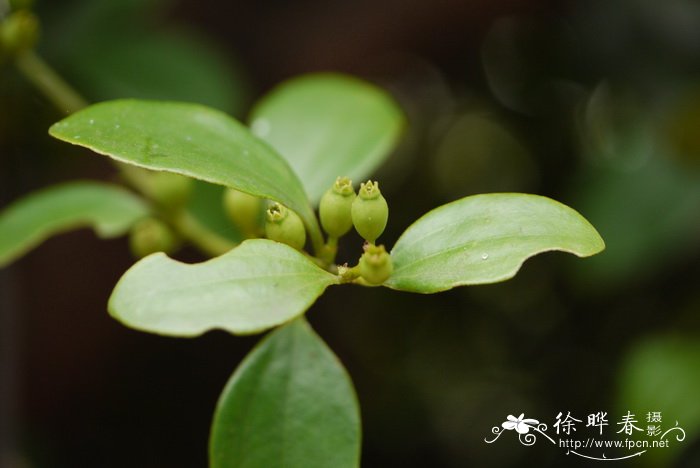寄生藤Dendrotrophe varians
中文名(Chinese Name):寄生藤
学名(Scientific Name):Dendrotrophe varians (Blume) Miq.
英文名(English Common Name):
别名(Chinese Common Name):青藤公、左扭香、鸡骨香藤
异名(Synonym):Dendrotrophe frutescens (Champ. ex Benth.) Y.T. Chang Dendrotrophe frutescens var. subquinquenervia (Tam) Tam Henslowia varians Blume Henslowia sessiliflora Hemsl. Henslowia frutescens Benth. Henslowia frutescens var. subquinquenervia P. C. Tam Dendrotrophe buxifolia var. minor (Ridl.) Stauffer Dendrotrophe cassiifolia (Blume) Miq. Dendrotrophe lobbiana (A.DC.) Miq. Dendrotrophe minor (Ridl.) Danser Dendrotrophe palawanensis (Elmer) Danser Dendrotrophe philippinensis (A.DC.) Miq. Dendrotrophe ridleyi (Gamble) Danser Dendrotrophe spicata (Blume) Miq. Dendrotrophe varians var. arfakensis Stauffer Dendrotrophe varians var. gracilior Stauffer Dendrotrophe varians var. minor (Ridl.) Stauffer Dendrotrophe varians var. multinervis Stauffer Dendrotrophe wrayi (Gamble) Danser Exocarpos amboinensis Merr. Henslowia palawanensis Elmer
科属(Family & Genus):檀香科(Santalaceae)寄生藤属Dendrotrophe
形态特征(Description):木质藤本,常呈灌木状;枝长2-8米,深灰黑色,嫩时黄绿色,三棱形,扭曲。叶厚,多少软革质,倒卵形至阔椭圆形,长3-7厘米,宽2-4.5厘米,顶端圆钝,有短尖,基部收狭而下延成叶柄,基出脉3条,侧脉大致沿边缘内侧分出,干后明显;叶柄长0.5-1厘米,扁平。花通常单性,雌雄异株;雄花:球形,长约2毫米,5-6朵集成聚伞状花序;小苞片近离生,偶呈总苞状;花梗长约1.5毫米;花被5裂,裂片三角形,在雄蕊背后有疏毛一撮,花药室圆形;花盘5裂;雌花或两性花:通常单生;雌花:短圆柱状,花柱短小,柱头不分裂,锥尖形;两性花,卵形。核果卵状或卵圆形,带红色,长1-1.2厘米,顶端有内拱形宿存花被,成熟时棕黄色至红褐色。花期1-3月,果期6-8月。
分布(Distribution):产于福建、广东、广西、云南。生长于海拔100-300米山地灌丛中,常攀援于树上。越南也有分布。
用途(Use):全株供药用,外敷治跌打刀伤。
引自中国植物志:FOC Vol. 5 Page 217
Dendrotrophe varians (Blume) Miquel, Fl. Ned. Ind. 1(1): 780. 1856.
寄生藤 ji sheng teng | Santalaceae | Dendrotrophe
Henslowia varians Blume, Mus. Bot. 1: 244. 1851; Dendrotrophe frutescens (Champion ex Bentham) Danser; D. frutescens var. subquinquenervia P. C. Tam; D. punctata C. Y. Wu & D. D. Tao; Henslowia frutescens Champion ex Bentham; H. frutescens var. subquinquenervia P. C. Tam; H. sessiliflora Hemsley.
Woody vines, usually shrubby, 1-8 m tall. Stems darkish black, yellowish green when young, 3-ribbed, twisted, ± smooth, sometimes reddish brown punctate. Petiole flat, 5-10 mm; leaf blade obovate to broadly elliptic, 3-7 × (1.4-)2-4.5 cm, thick, ± leathery, basal veins 3-5, prominent when dry, base narrowed and decurrent to form petiole, less often rounded, apex obtuse. Male inflorescences umbellate or cymose, 5- or 6-flowered; peduncle to 20 mm; bracteoles 7 or 8, ovate-triangular. Female inflorescences usually of solitary flowers; peduncle 3-4 mm. Flowers usually unisexual (plants usually dioecious). Male flowers globose, ca. 2 mm; pedicel ca. 1.5 mm; bracteoles triangular-ovate, ca. 1 mm; perianth lobes triangular, ca. 1.5 mm; stamen filaments ca. 0.5 mm, with a tuft of hair behind each, cells rounded. Disk 5-lobed to annular. Female flowers: bracteoles 3-5; perianth short terete, 2-3 mm, lobes 5, ovate-triangular, ca. 1 × 1 mm; staminodes present. Style short, stigma not lobed, needle-like. Bisexual flowers ovoid. Drupe reddish, brownish yellow to reddish brown when mature, ovoid, 10-13 mm, inconspicuously 5-ribbed; persistent perianth lobes incurved. Fl. Jan-Mar, fr. Jun-Aug.
Thickets, usually climbing on trees; 100-300 m. Fujian, Guangdong, Guangxi, Hainan [Indonesia, Malaysia, Myanmar, Philippines, Thailand, Vietnam].
Dendrotrophe punctata was described from material with densely punctate stems and leaves, but such gland dots occur sporadically in collections from at least both China and Thailand, and there is no clear division between D. punctata and the very widespread and variable D. varians. There are additional probable synonyms based on collections from Indonesia and the Philippines.
The plants are used medicinally.




(责任编辑:徐晔春)
学名(Scientific Name):Dendrotrophe varians (Blume) Miq.
英文名(English Common Name):
别名(Chinese Common Name):青藤公、左扭香、鸡骨香藤
异名(Synonym):Dendrotrophe frutescens (Champ. ex Benth.) Y.T. Chang Dendrotrophe frutescens var. subquinquenervia (Tam) Tam Henslowia varians Blume Henslowia sessiliflora Hemsl. Henslowia frutescens Benth. Henslowia frutescens var. subquinquenervia P. C. Tam Dendrotrophe buxifolia var. minor (Ridl.) Stauffer Dendrotrophe cassiifolia (Blume) Miq. Dendrotrophe lobbiana (A.DC.) Miq. Dendrotrophe minor (Ridl.) Danser Dendrotrophe palawanensis (Elmer) Danser Dendrotrophe philippinensis (A.DC.) Miq. Dendrotrophe ridleyi (Gamble) Danser Dendrotrophe spicata (Blume) Miq. Dendrotrophe varians var. arfakensis Stauffer Dendrotrophe varians var. gracilior Stauffer Dendrotrophe varians var. minor (Ridl.) Stauffer Dendrotrophe varians var. multinervis Stauffer Dendrotrophe wrayi (Gamble) Danser Exocarpos amboinensis Merr. Henslowia palawanensis Elmer
科属(Family & Genus):檀香科(Santalaceae)寄生藤属Dendrotrophe
形态特征(Description):木质藤本,常呈灌木状;枝长2-8米,深灰黑色,嫩时黄绿色,三棱形,扭曲。叶厚,多少软革质,倒卵形至阔椭圆形,长3-7厘米,宽2-4.5厘米,顶端圆钝,有短尖,基部收狭而下延成叶柄,基出脉3条,侧脉大致沿边缘内侧分出,干后明显;叶柄长0.5-1厘米,扁平。花通常单性,雌雄异株;雄花:球形,长约2毫米,5-6朵集成聚伞状花序;小苞片近离生,偶呈总苞状;花梗长约1.5毫米;花被5裂,裂片三角形,在雄蕊背后有疏毛一撮,花药室圆形;花盘5裂;雌花或两性花:通常单生;雌花:短圆柱状,花柱短小,柱头不分裂,锥尖形;两性花,卵形。核果卵状或卵圆形,带红色,长1-1.2厘米,顶端有内拱形宿存花被,成熟时棕黄色至红褐色。花期1-3月,果期6-8月。
分布(Distribution):产于福建、广东、广西、云南。生长于海拔100-300米山地灌丛中,常攀援于树上。越南也有分布。
用途(Use):全株供药用,外敷治跌打刀伤。
引自中国植物志:FOC Vol. 5 Page 217
Dendrotrophe varians (Blume) Miquel, Fl. Ned. Ind. 1(1): 780. 1856.
寄生藤 ji sheng teng | Santalaceae | Dendrotrophe
Henslowia varians Blume, Mus. Bot. 1: 244. 1851; Dendrotrophe frutescens (Champion ex Bentham) Danser; D. frutescens var. subquinquenervia P. C. Tam; D. punctata C. Y. Wu & D. D. Tao; Henslowia frutescens Champion ex Bentham; H. frutescens var. subquinquenervia P. C. Tam; H. sessiliflora Hemsley.
Woody vines, usually shrubby, 1-8 m tall. Stems darkish black, yellowish green when young, 3-ribbed, twisted, ± smooth, sometimes reddish brown punctate. Petiole flat, 5-10 mm; leaf blade obovate to broadly elliptic, 3-7 × (1.4-)2-4.5 cm, thick, ± leathery, basal veins 3-5, prominent when dry, base narrowed and decurrent to form petiole, less often rounded, apex obtuse. Male inflorescences umbellate or cymose, 5- or 6-flowered; peduncle to 20 mm; bracteoles 7 or 8, ovate-triangular. Female inflorescences usually of solitary flowers; peduncle 3-4 mm. Flowers usually unisexual (plants usually dioecious). Male flowers globose, ca. 2 mm; pedicel ca. 1.5 mm; bracteoles triangular-ovate, ca. 1 mm; perianth lobes triangular, ca. 1.5 mm; stamen filaments ca. 0.5 mm, with a tuft of hair behind each, cells rounded. Disk 5-lobed to annular. Female flowers: bracteoles 3-5; perianth short terete, 2-3 mm, lobes 5, ovate-triangular, ca. 1 × 1 mm; staminodes present. Style short, stigma not lobed, needle-like. Bisexual flowers ovoid. Drupe reddish, brownish yellow to reddish brown when mature, ovoid, 10-13 mm, inconspicuously 5-ribbed; persistent perianth lobes incurved. Fl. Jan-Mar, fr. Jun-Aug.
Thickets, usually climbing on trees; 100-300 m. Fujian, Guangdong, Guangxi, Hainan [Indonesia, Malaysia, Myanmar, Philippines, Thailand, Vietnam].
Dendrotrophe punctata was described from material with densely punctate stems and leaves, but such gland dots occur sporadically in collections from at least both China and Thailand, and there is no clear division between D. punctata and the very widespread and variable D. varians. There are additional probable synonyms based on collections from Indonesia and the Philippines.
The plants are used medicinally.
(责任编辑:徐晔春)
踩一下[1]

顶一下[3]